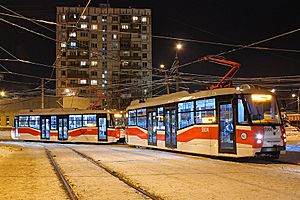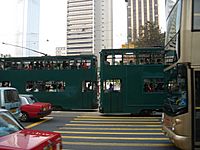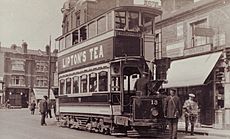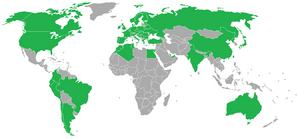Tram facts for kids



A tram (also called a tramcar, trolley, or streetcar) is a passenger vehicle. It is like a light train that carries people around a city. Trams can carry many people at once. Riding a tram instead of driving a car helps reduce pollution and makes the roads less busy.
The word tram is mostly used outside North America. In North America, these vehicles are called streetcars or trolleys. This is because they usually run on city streets.
Newer and larger trams made since the 1970s are often called light rail vehicles. The tram in the second picture from Warsaw is an example. These vehicles are bigger because they often have two or more parts. They have a bendy section in the middle, like a human joint. In railway language, these are called "articulated" vehicles. Light rail vehicles sometimes have their own special tracks, not on the street. Their stops are also usually farther apart, so they can travel faster.
In San Francisco, old streetcars from the 1910s to the 1940s are a popular tourist attraction. They are called "historic streetcars" and run on the F Market line. Another city famous for its trams is Hong Kong. Trams there have two floors, which is very rare around the world. Tourists love riding them.
The biggest tram networks in the world are in: Melbourne, St. Petersburg, Amsterdam, Berlin, Moscow, and Vienna.
History of Trams
Trams first started being used in the 1890s. They took the place of "horsecars," which were streetcars pulled by horses.
From the 1910s to the 1930s, some metropolitan areas in North America had special, longer streetcars. These traveled long distances to far-off suburbs on lines called interurban lines. These streetcar lines sometimes had their own special tracks and made fewer stops. This helped them travel faster.
In the late 1940s and early 1950s, in the United States, some large companies worked together. These included an oil company, a car company, and a tire company. They bought many streetcar systems. Then, they removed the tracks and replaced the trams with buses in many cities across North America. They did this to earn more money by selling more oil, buses, cars, and rubber tires.
Because of this, cities had to spend a lot of money in the 1980s and 1990s. They rebuilt the streetcar systems as light rail systems, using modern light rail vehicles.
Related pages
Images for kids
-
The Artic X34 tram vehicle in Tampere, Finland.
-
Horse-drawn trams were used in New York City until 1917.
-
Winding drums of the London and Blackwall cable-operated railway.
-
The first cable car service in Melbourne, 1885. Melbourne had one of the largest cable car networks in the world from its start until 1940.
-
A San Francisco cable car in 2008. Cable cars work well in hilly areas, which is why they are still used in San Francisco.
-
Gross-Lichterfelde Tram in 1882. Early electric trams from this company did not use overhead wires. They got power from the rails.
-
Volk's Electric Railway, around 1890. Opened in 1883, it is the world's oldest electric tramway still running.
-
Convict tramways were human-powered tramways used in Port Arthur.
-
Overhead lines are used to power most electric trams. Both trams and light rail systems use overhead wires.
-
A section of APS track in Bordeaux with powered and neutral parts.
-
Made in 1923 and 1924, the 900 Series tram is still used by the New Orleans tram system. Trams usually last longer than buses that use gasoline.
-
A tram in Chengdu. Its line is part of the Chengdu Metro. Chengdu is one of several cities in China that have invested in tram systems in the early 21st century.
-
Cologne Stadtbahn is the largest tram network in the European Union.
-
A painting of Auckland in 1889 with horse-drawn trams on the road.
-
PreMetro line E2 is a tram network that has been running in Buenos Aires since 1987.
-
A sign in Portland that says "go by streetcar." Trams are usually called streetcars in North America.
-
Preserved Linke-Hofmann-Busch tram, in Kraków, Poland.
See also
 In Spanish: Tranvía para niños
In Spanish: Tranvía para niños



































